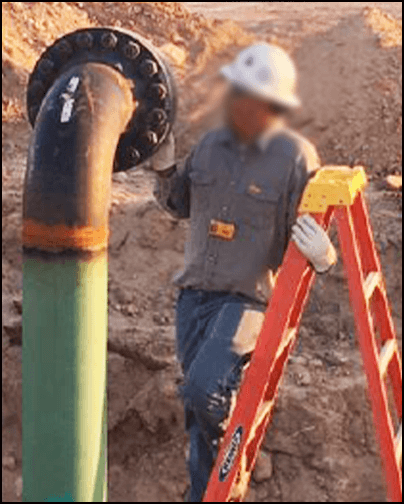-
What happened?
A hydro test crew was reducing pressure from 1950 psi (pounds per square inch) on a 10 inch/25 cm gas sales line.
700 feet/215 metres away, a worker who was not part of the hydro test crew, bled down the pressure on a 1 inch/2.5 cm high point bleed.
The work was stopped as soon as the incident was identified, and management was notified.
No injuries occurred as a result of this incident, but potentially there could have been a significant release of pressure causing serious injury.

-
Why did it happen?
Execution of critical barriers for critical tasks was not fully understood by contracted employees.
A safety talk on critical task and barriers for injury prevention involving all crews did not take place.
There was a significant miscommunication between the crews working at the same location. This likely led to a plug with (unidentified) considerable pressure behind it to be removed.

-
What did they learn?
All crews working simultaneously at the same site should understand the execution of critical tasks and barriers.
The crews should communicate between themselves during critical tasks.
Safety talks focusing on critical tasks and barriers should be held with all crews (including contractors).
As soon as an incident is identified, stop work!

-
Ask yourself or your crew
How can something like this happen here?
What other tasks are going on nearby?
What are the critical barriers in place on today’s task?
How can we improve communication with contractor crews on-site?
If something similar occurs today on our site, what would you do?

Add to homescreen
Content name
Select existing category:
Content name
New collection
Edit collection
What happened?
A hydro test crew was reducing pressure from 1950 psi (pounds per square inch) on a 10 inch/25 cm gas sales line.
700 feet/215 metres away, a worker who was not part of the hydro test crew, bled down the pressure on a 1 inch/2.5 cm high point bleed.
The work was stopped as soon as the incident was identified, and management was notified.
No injuries occurred as a result of this incident, but potentially there could have been a significant release of pressure causing serious injury.

Why did it happen?
Execution of critical barriers for critical tasks was not fully understood by contracted employees.
A safety talk on critical task and barriers for injury prevention involving all crews did not take place.
There was a significant miscommunication between the crews working at the same location. This likely led to a plug with (unidentified) considerable pressure behind it to be removed.

What did they learn?
All crews working simultaneously at the same site should understand the execution of critical tasks and barriers.
The crews should communicate between themselves during critical tasks.
Safety talks focusing on critical tasks and barriers should be held with all crews (including contractors).
As soon as an incident is identified, stop work!
Ask yourself or your crew
How can something like this happen here?
What other tasks are going on nearby?
What are the critical barriers in place on today’s task?
How can we improve communication with contractor crews on-site?
If something similar occurs today on our site, what would you do?
A hydrotest crew was reducing pressure on a gas sales line. A worker who was not part of the hydrotest crew bled down the pressure on a high point bleed. The work was stopped, and management was notified.














